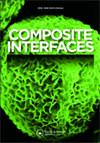Roles of different organic-inorganic hybrid interfaces in enhancing the mechanical properties of continuous basalt fiber/epoxy composites
IF 2.4
4区 材料科学
Q3 MATERIALS SCIENCE, COMPOSITES
引用次数: 0
Abstract
ABSTRACTIn order to enhance the interfacial adhesion between continuous basalt fibers (CBFs) and epoxy (EP) matrix and the mechanical properties of resultant composites, the organic – inorganic hybrid compatibilization layer (OIHCL) composed of flexible 1,6-hexanediol diglycidyl ether (HDE) chains and rigid nano-silica (SiO2) is grafted on CBFs surface. With increasing the SiO2 content in the OIHCL, the structure and composition of the OIHCL change from a single layer composed of a well-dispersed SiO2 phase and continuous HDE phase to a double layer composed of an HDE/SiO2 inner-layer and aggregated SiO2 outer-layer. And, the effects of different OIHCLs on the mechanical performances of resultant composite are studied in details. The results show that the single-layer OIHCL exhibits stronger reinforcing effects in the interfacial shear strength (IFSS), tensile strength, and flexural strength of resultant composite. For example, the IFSS, tensile strength, and flexural strength of the CBFs-g-12.5%-(HDE/SiO2)/EP composite can reach 47.1 MPa, 466.1 MPa, and 660.5 MPa, respectively. Furthermore, the impact strength of the CBF/EP composites can be effectively enhanced by only grafting a flexible HDE layer on CBF surfaces. Finally, the aggregated SiO2 derived from the outer-layer of double-layer OIHCLs can deteriorate the interfacial adhesion, and all mechanical performances of resultant composites.KEYWORDS: Surface modificationinterface/interphasepolymer-matrix compositescontinuous basalt fibermechanical properties Disclosure statementThe authors declare that they have no known competing financial interests or personal relationships that could have appeared to influence the work reported in this paper.Author contributionsZ.Y. was mainly responsible for the most of experimental work and the related measurements. SC.Z. was mainly responsible for the experimental design, the result analysis, the manuscript writing, and the foundation supporting. Y.Z was responsible for the experiment work about Molecules Simulation. Q.X contributed to the analysis of the results. M.J was mainly responsible for the foundation supporting and the result analysis. P.L and SY.Z. were responsible for the experimental supervision and paper critical revision.Supplemental dataSupplemental data for this article can be accessed online at https://doi.org/10.1080/09276440.2023.2264041Additional informationFundingThe authors were grateful to the Science and Technology Program of Sichuan Province (No. 2023YFG0342) and the Open Project Program of Basalt Fiber and Composite Materials Key Laboratory of Sichuan Province (No. SZXX202004) for financial support.不同有机-无机杂化界面对增强连续玄武岩纤维/环氧复合材料力学性能的作用
摘要为了增强连续玄武岩纤维(CBFs)与环氧树脂(EP)基体之间的界面附着力和复合材料的力学性能,在连续玄武岩纤维(CBFs)表面接枝了由柔性1,6-己二醇二甘油酯(HDE)链和刚性纳米二氧化硅(SiO2)组成的有机-无机杂化增容层(OIHCL)。随着OIHCL中SiO2含量的增加,OIHCL的结构和组成由由分散良好的SiO2相和连续的HDE相组成的单层转变为由HDE/SiO2内层和聚集的SiO2外层组成的双层结构。并详细研究了不同oihcl对复合材料力学性能的影响。结果表明:单层OIHCL对复合材料的界面抗剪强度、抗拉强度和抗折强度具有较强的增强作用;例如,CBFs-g-12.5%-(HDE/SiO2)/EP复合材料的IFSS、抗拉强度和抗弯强度分别达到47.1 MPa、466.1 MPa和660.5 MPa。此外,仅在CBF表面接枝柔性HDE层即可有效提高CBF/EP复合材料的冲击强度。最后,来自双层oihcl外层的SiO2聚集会破坏复合材料的界面附着力和所有力学性能。关键词:表面改性界面/界面聚合物基复合材料连续玄武岩纤维力学性能披露声明作者声明他们没有已知的竞争经济利益或个人关系可能会影响本文所报道的工作。作者contributionsZ.Y。主要负责大部分的实验工作和相关的测量。SC.Z。主要负责实验设计、结果分析、稿件撰写、基础支持。Y.Z负责分子模拟的实验工作。Q.X对结果进行了分析。M.J主要负责基础支护和结果分析。P.L和SY.Z。负责实验监督和论文的关键性修改。作者感谢四川省科技计划项目(No. 2023YFG0342)和四川省玄武岩纤维及复合材料重点实验室开放项目(No. 2023YFG0342)。SZXX202004)资金支持。
本文章由计算机程序翻译,如有差异,请以英文原文为准。
求助全文
约1分钟内获得全文
求助全文
来源期刊

Composite Interfaces
工程技术-材料科学:复合
CiteScore
5.00
自引率
3.80%
发文量
58
审稿时长
3 months
期刊介绍:
Composite Interfaces publishes interdisciplinary scientific and engineering research articles on composite interfaces/interphases and their related phenomena. Presenting new concepts for the fundamental understanding of composite interface study, the journal balances interest in chemistry, physical properties, mechanical properties, molecular structures, characterization techniques and theories.
Composite Interfaces covers a wide range of topics including - but not restricted to:
-surface treatment of reinforcing fibers and fillers-
effect of interface structure on mechanical properties, physical properties, curing and rheology-
coupling agents-
synthesis of matrices designed to promote adhesion-
molecular and atomic characterization of interfaces-
interfacial morphology-
dynamic mechanical study of interphases-
interfacial compatibilization-
adsorption-
tribology-
composites with organic, inorganic and metallic materials-
composites applied to aerospace, automotive, appliances, electronics, construction, marine, optical and biomedical fields
文献相关原料
公司名称
产品信息
阿拉丁
1,6-hexanediol diglycidyl ether
阿拉丁
Dimethylimidazole
阿拉丁
3-aminopropyltriethoxysilane (KH550)
 求助内容:
求助内容: 应助结果提醒方式:
应助结果提醒方式:


